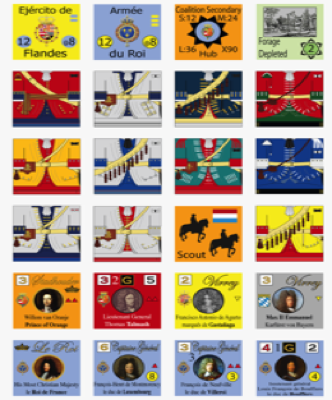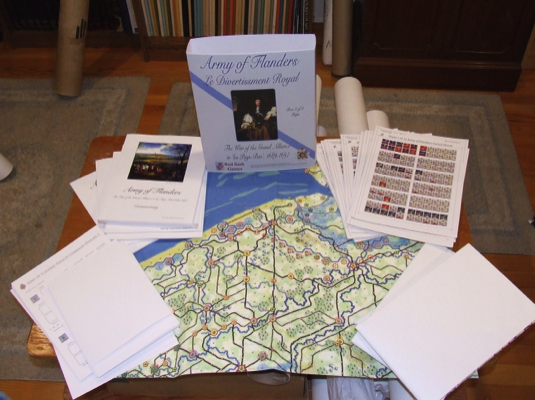The Game
Army of Flanders (AOF) is the thirteenth volume in Red Sash Games' Lace Wars series and is the third in a set of four dealing with the War of the Grand Alliance (1688-1697). This war, sometimes called the War of the League of Augsburg or the Nine Years War, was the second of the three great wars of Louis XIV. As a young man he waged the Dutch War to expand France's borders. That was a war of aggression. As an old man he fought the War of the Spanish Succession to put his grandson on the throne of Spain. Despite the Sun King's ultimate aim, that was only a defensive war. The War of the Grand Alliance was Louis' war of middle age – a war of grinding attrition involving nearly a million men. Ironically, Louis did not want to fight in Flanders. This was supposed to be a short war, in which his main rival, Spain, would lose Luxembourg, and France would also acquire Cologne as a puppet state with a view to gradually isolating the Spanish Netherlands and the Dutch, whose armies guaranteed the security of the region. Things did not go as planned. For nine years the armies of France and the Grand Alliance, led by William of Orange, the Dutch commander-in-chief and King of England, crossed and recrossed the lands of Flanders and Brabant, until the territory now called Belgium became a wasteland. Until 1694 the French were led by the Duke of Luxembourg. Despite his title he was a French nobleman, close to the Throne. He was also the premier general of his age, ranking with Turenne and the Great Condé; no general of the Alliance could match him. But, the Alliance had money, and that meant staying power. Huge armies were raised and deployed on both sides – not just 'huge' by the standards of 'ye olden days', but on occasion topping 150,000 men apiece. With such large armies sewn onto a premodern logistics system, much damage was done but no 'lightning war' triumph was possible. Ultimately, King Louis recognised he could not win. Fortunately, his diplomatic service was as outstanding as his military machine, so he was not forced to lose, either. Both sides went through financial disasters that threatened to wreck all their schemes – only pride kept them fighting – but the French recovered first, and a final, relatively minor offensive in the last year of the war allowed Louis to claim a win 'on points'. The real reason the war ended lay in Italy, where Duke Victor of Savoy, with French prodding, switched sides (in 1696), leading to a scramble for peace.
In Army of Flanders, you will have a chance to change history – and even if you cannot, perhaps you can win enough glory to write your name in the history books. Flanders is the source of Gloire… and the graveyard of reputations. As the French, will you pursue an offensive or a defensive strategy? The French Army is state-of-the-art. You have more artillery, the latest equipment (bayonets instead of pikes), and access to an administrative machine capable of supporting nearly 500,000 men. But you are under the eye of Versailles, only a couple of days' ride from the Front. You are mere an extension of the Sun King's will. If his reputation needs patching up, expect to be ordered to lay siege to some massive fortress that will bleed your armies dry. At least you will be given the resources you need. But, if the King decides to pursue diplomacy, you will have to secure and 'rationalise' the Frontier. If you fail you will lose the respect of the Court Ladies. If you disobey, well, that does not bear thinking about… As the Allied commander you lead a motley collection of troops: Dutch, British, Spanish, Germans, Huguenots, Danes, Swedes, and even the not inconsiderable army of Liège. The Germans want to pursue a Rhine strategy. The Spanish want to hunker down and let the Dutch do all the fighting. The Dutch Commissars say you are spending too much money. The British Isles are still being subjugated by the Prince of Orange. In the early years it will be enough to hold the line. Later, hopefully, the French will run out of steam and you can pay them back in their own coin!
Components
1) Four map sections representing the lands of Flanders, Brabant, and Luxembourg, from the Channel Coast to the Meuse River.
2) 1800 counters representing the forces of the French and the Grand Alliance. Scale is Battalion – that is, the playing pieces represent battalions and regiments.
3) Rules, charts, tables, and display cards.
4) An historical commentary.

